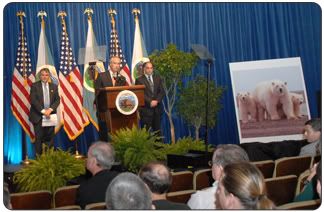Looking Closer At The Polar Bear Listing
 Interior Secretary Dirk Kempthorne tried to mute the impact of his listing today of the polar bear by assuring us in his comments that he's covered our fears of economic meltdown by preparing an administrative guidance:
Interior Secretary Dirk Kempthorne tried to mute the impact of his listing today of the polar bear by assuring us in his comments that he's covered our fears of economic meltdown by preparing an administrative guidance:“I am also announcing that this listing decision will be accompanied by administrative guidance and a rule that defines the scope of impact my decision will have, in order to protect the polar bear while limiting the unintended harm to the society and economy of the United States.” ...Forget it; the guidance might as well have been written on toilet paper; it cannot alter the provisions of ESA, and you have to dig no further into the final rule to find this:
[Fish & Wildlife Service] Director [Dale] Hall will issue guidance to Fish and Wildlife Service staff that the best scientific data available today cannot make a causal connection between harm to listed species or their habitats and greenhouse gas emissions from a specific facility, or resource development project, or government action.
This final rule activates the consultation provisions of section 7 of the Act for the polar bear.That means that any project in the US -- Alaska or lower 48 or anywhere else our flag flies -- that could increase greenhouse gases will now be subject to a challenge by enviros if it doesn't undergo a section 7 review, and that they will almost certainly win those challenges. So thanks to Kempthorne's pathetic punt today, projects like factories, power plants (as if we'll ever build another one of those), developments on the urban fringe and new roads or transmission lines will be challenged, and subsequently cut back, delayed or even stopped.
This was the Greens' intent all along; otherwise they wouldn't have petitioned for listing, so they won very big today. Even so, the mere mention of the guidance document got the paranoid hyper-greens on the left hysterical and paranoid, as evidenced by this blogger:
Ah ha! Since the news on this is just filtering out this minute, you'll forgive me for my delusional optimism spawned from the new listing rule for the imperiled polar bear. No, you knew it was too good to be true that the Fish and Wildlife Service's acknowledgment that the polar bear is threatened by sea ice loss and that sea ice is lost by global warming would mean that we would try to stop global warming.That will be the Greenie/Warmie response, and they will argue it time and again on project after project, periodically finding sympathetic judges and setting detrimental precedents.
[He then quotes parts of the same Kempthorne quote]
No, we must instead continue to "allow continuation of vital energy production in Alaska," i.e. drill for oil in polar bear habitat. Right. Of course we do. Must. Protect. The. Oil. Economy.
Alaska, Iraq, Afghanistan.... all territories conquered by the Army of Big Oil. And we know who is the Commander in Chief of that particular military.
Accompanying the decision was a special rule, allowed under section 4(d) of the act only for threatened listings like today's, not endangered listings. We have used 4(d)s in the past to circumvent some of the more onerous aspects of a listing, but this one is pretty darn milquetoast, dealing mostly with things like Native American take of bears.
There is, however, a lengthy section on successful mitigation measures for oil and gas exploration in Alaska, specifying things like having no operations within a mile of a polar bear den, and having bear biologists on hand to monitor operations. The results of these measures, says the rule, have been positive:
Data provided by monitoring and reporting programs in the Beaufort Sea and in the Chukchi Sea, as required under the incidental take authorizations for oil and gas activities, have shown that the mitigation measures have successfully minimized effects on polar bears. For example, since 1991, when the incidental take regulations became effective in the Chukchi and Beaufort Seas, there has been no known instance of a polar bear being killed or of personnel being injured by a bear as a result of oil and gas industry activities. The mitigation measures associated with the Beaufort Sea incidental take regulations, which, based on the monitoring and reporting data, have proven to minimize human–bear interactions, will be part of the Chukchi Sea incidental take regulations currently under review.That could give some cover to Alaskan oil ops, but the Greenies/Warmies will peck away at it, creating more and more restrictions, limiting the number of days exploration or extraction can occur, challenging the roadway that links the Prudhoe Bay facilities to the South, ad infinitum. And what of oil projects in, say, Texas or Montana? For that and any other industrial development, the 4(d) also tries to limit when section 7 consultations will be required:
But in the simplest terms, a Federal agency evaluates whether consultation is necessary by analyzing what will happen to listed species or critical habitat “with and without” the proposed action. Typically, this analysis will review direct effects, indirect effects, and the effects that are caused by interrelated and interdependent activities to determine if the proposed action “may affect” listed species or critical habitat. For those effects beyond the footprint of the action, our regulations at 50 CFR 402.02 require that they both be “caused by the action under consultation” and “reasonably certain to occur.” That is, effects are only appropriately considered in a section 7 analysis if there is a causal connection between the proposed action and a discernible effect to the species or critical habitat that is reasonably certain to occur. One must be able to “connect the dots” between the proposed action, an effect, and an impact to the species and there must be a reasonable certainty that the effect will occur.This is clearly an attempt to limit the enforcement of the provisions of Section 7 only to those projects that would, say, slap a subdivision down over a bunch of polar bear dens, or light big bonfires on the shrinking icecap. Would that it were so.
Again, all the Greenies/Warmies have to do is find a judge who finds a direct correlation between the emissions of a factory in Kansas to the melting of ice in the Arctic, and they're off and running. There are precedents that have protected property owners from the arbitrary and capricious enforcement of Section 7, notably Arizona Cattlegrowers’ Association v. U.S. Fish and Wildlife Service (273 F.3d 1229, 9th cir. 2001), but everything is endlessly challengable in the ESA world, and challenges mean delay, which mean negative economic impact and sometimes dead projects.
A bolder administration would have said that because polar bear populations have increased, because last summer's loss of polar sea ice was more than made up for with this freezing winter's massive new formations, and because the US has cut carbon emissions substantially and is on the way to cutting them further, a listing isn't warranted at this time.
Not doing so is probably just a sign of how weak and disappointing the Bush administration has become. There is an argument that could be made that this is all strategery, i.e., better to get a "threatened" listing with a guidance and a 4(d) from this administration than a real stinker for the next administration ... but I'm tired of scanning the distant horizons for some sign of good performance from the inept Bush administration ... beyond the surge, anyway. Thank God for the surge.
Labels: Climate change, Endangered Species, Global warming, Polar bears




<< Home